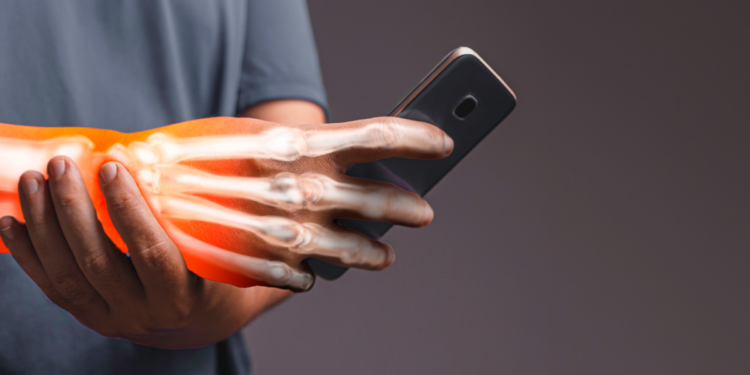Many people sustain a lifetime’s worth of microtraumas without ever encountering the word, microtrauma. These injuries can be so slight that they go unnoticed, and they involve areas that include joints, ligaments, tendons, muscles and sometimes bone.
Over time, like a tower of blocks, microtraumas can build one on top of another until the tower crashes, resulting in a stress injury.
Stress injuries include musculoskeletal and bone damage from excessive activity or force. A type of stress injury is “repetitive strain” or repetitive stress injury (RSI). It is caused by repeated motion and overuse of soft tissue, such as muscles, nerves, and tendons. Repetitive strain and RSIs can affect hands, shoulders, backs, and knees, often leading to chronic conditions.
Common RSIs include:
- Bursitis
- Carpal tunnel syndrome
- Stress fracture
- Tendinitis
- Tennis elbow
- Trigger finger/trigger thumb
Lifestyles dominated by smartphones, laptops, desktops, and video games, combined with subpar ergonomics and a tendency to dismiss or push through pain, are behind many of today’s microtraumas.
According to a recent report by the Entertainment Software Association, 212.6 million Americans play video games weekly. Gaming is an activity closely connected to the development of carpal tunnel syndrome and other health conditions.
Specific Health Conditions Caused by RSIs
Let’s examine microtraumas in relation to the following RSIs: carpal tunnel syndrome, bursitis, and tendinitis.
Carpal Tunnel Syndrome
The wrist’s carpal tunnel contains ligaments and bones through which the median nerve passes. Stress on this nerve causes pain, numbness, tingling, and weakness in the hands and wrists. Carpal tunnel syndrome is caused by cooking, gaming, texting and typing.
Preventions include correct posture and wrist position, healthful ergonomics, stretching and rest. Treatment sometimes requires splints.
Carpal tunnel syndrome can be caused by tasks such as typing, woodworking, playing musical instruments, cooking, and even drawing, and it is a major source of workplace injuries. A recent article from the Society for Human Resource Management said ergonomic injuries rank second on the list of top five office hazards. According to the Entertainment Software Association, 65% of Americans play video games every week.
Bursitis
Bursae are sacs of fluid that help joints move smoothly. When a bursa becomes inflamed, it results in bursitis, commonly affecting shoulders, elbows, and hips. A baseball pitcher might develop shoulder bursitis, whereas a catcher might have knee bursitis.
Rest, ergonomics, stretches, and targeted exercise prevent bursitis and are also among its treatments.
Tendinitis
Tendons are tissues that hold muscle and bone together. Factors including overuse and RSIs cause tendinitis, with pain and impediments to mobility. Tendinitis is often associated with sports, including tennis and swimming, and with repetitive tasks, such as assembly line work. Improper lifting, insufficient conditioning, overuse, and poor spinal alignment/posture are also factors.
Prevention includes warmups, adequate breaks, proper technique and effective ergonomics. Strengthening muscle, managing diabetes and arthritis, and the right footwear can also help. Treatment may include applied heat and in rare instances, patients undergo surgery.
Stress Fracture
Stress fractures are tiny bone cracks, usually in the legs and feet. Stress fractures are more likely when the body lacks time to replenish bone tissue. Proper footwear, correct technique in dancing and sports, and good posture are important.
Chiropractic care, physical therapy, and sometimes occupational therapy can be effective. All are holistic and noninvasive, meaning they consider the whole person and their living circumstances when treating patients, and treatments are nonsurgical. These practitioners know how to avoid microtrauma and can identify posture problems, musculoskeletal issues, and soft tissue injuries.
Often, the body warns us, with aches, pains, and pings, that damage is occurring. Dismissing them as “no big deal” or just part of the process can make matters worse.
In All Things, Balance
Full recovery from an RSI is possible depending on factors such as the type and seriousness of the injury and the amount of time without treatment. Prompt treatment also increases the likelihood that conditions will be successfully managed if they become chronic.
We’ve seen how lifestyles such as manual labor can dramatically alter the appearance of the human body. Now, we are seeing the effects of gaming, texting, and keyboarding in the form of “shrimp posture” and “tech neck,” as they slowly force shoulders downward and heads forward.
Microtrauma reforms, restructures and almost chisels out a different person. Prevention of RSIs is a key to enjoying our digital devices in ways we won’t regret a few years from now.



